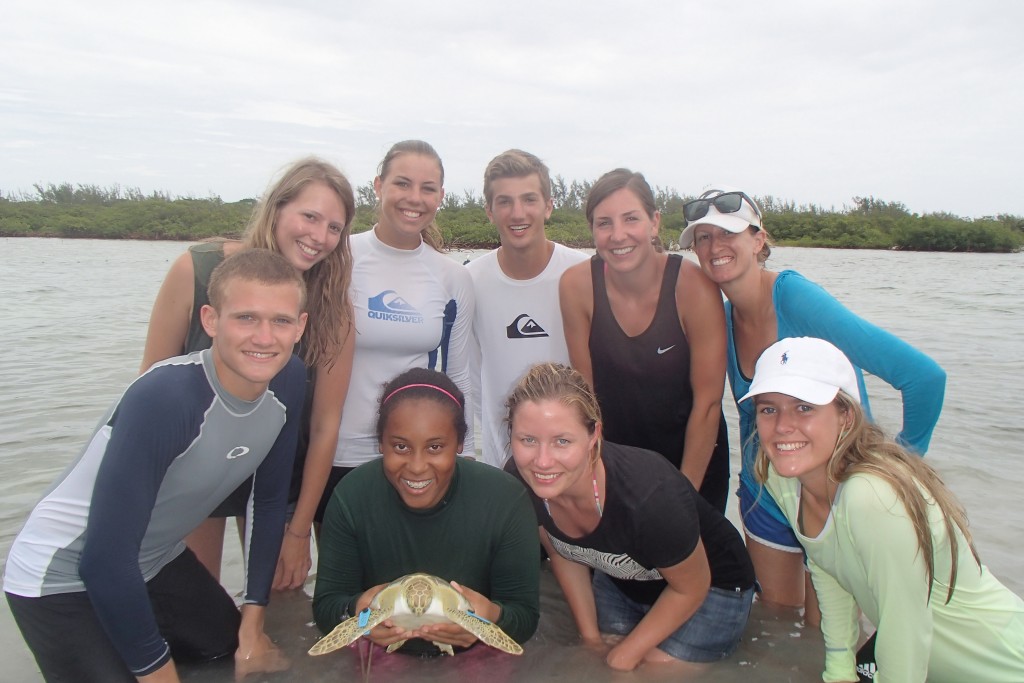The Bahamas has an abundance of inland ponds that are rarely visited and poorly studied. These inland ponds are fragile ecosystems that are under threat from developments, pollution and the introduction of species, yet these ponds are rarely considered for conservation protection. Eleuthera has over 200 of these inland water sites. One of these, Sweetings pond, has an unusually high number of seahorses. This pond may not be the only special site, as these isolated ponds are known to support unique and endemic life. This semester, Island School students started to explore and assess the ponds of South Eleuthera to provide data to ensure their long-term conservation. Excitingly we found new species, please visit the CEI blog for more details.
Tag Archives: research
Student Update: Fishing
Research fun day: a highly anticipated day by all groups, everyone trying to out do the other. Our schedule was set, leave at 1:15 and stay out on the water until 7:15, fishing and trawling with a little snorkeling mixed in. With dinner and snack in abundance, bait and lures, and life jackets for all we set out into the Sound for a day of fishing and fun. The fist highlight of the day came when 5 minutes out of the dock an eagle ray jumped out of the water right in front of our boat. This set the tone for the next 6 hours- complete and utter awesomeness. Another hour of trolling with no luck was quickly forgotten when 2 pilot whales were sighted off the right side of the boat. The chase was on, but soon it wasn’t us being chased, both whales turned right at the boat and in moments were 10 feet away. Spirits high we set out and soon after the whale episode two Mahi hit the line simultaneously and Jeremy and Delphine landed them both. Cooler stocked we continued toward the evening sun at 7 knots, and feasted on sandwiches, GORP and cassava chips. More pilot whales appeared in front of us, and then a few behind us, and another to the left, and soon all around the boat was a school of 20 pilot whales feeding. The moment was short lived however because the sought after sound of the line being pulled whizzed by and a 4ft silky shark soon joined us on the boat, before we let it go. A patch of seaweed ripe for snorkeling appeared and a few of our team took the opportunity for a dip, only to get the opportunity to see a 5 ft Galapagos shark. Quickly back on the boat and a nice sunset ride home close what was a particularly memorable Island School evening.
-Ethan Pierce

Island School Research Class Helps Assess the Local Reef Invertebrate Populations
Read about some of the amazing real-world work Island School students are doing in their research class taught by researchers at the Cape Eleuthera Institute!
Student Update: Turtle Research
Research classes are in full gear as students put together the results sections of their projects and start to assemble their final posters. Here’s what student Lane Kearney had to say about her Turtle project.
One by one we toss our fins and snorkels onto the Scute, a small, single engine motorboat. We all pile in and position ourselves so all 8 of our eyes are on the water. The search now begins. Green turtles are hard to spot in this creek. Underneath the still aqua water, sits an array of coral blocks. While the boat is moving, it is easy to mistake these stationary objects as sea turtles. We all keep our eyes transfixed on the oceans surface until one of us shouts, “Turtle!!” This is when the excitement begins. I double check to make sure my fins are securely on my feet. I grab my mask, and speedily put it on my face. I fling my legs over the side of the tiny boat, and wait for Annabelle’s voice. “Go!!” I use my hands to propel myself into the warm waters. As soon as I hit, my arms and legs start moving as fast as I can. There is one thing on my mind, “catch the turtle.” My arms pierce through the water as I power myself towards the turtle. The turtle is using all its might to get as far away from me as it can; I won’t give up.
He finally dips down into the water and then starts to make his way to the surface for a breath, this is my chance. I reach my arms out, and grab under his front flippers, the turtle’s strongest joint. I have him in my hands. He fusses and moves his flippers around in all directions. As he is squirming frantically in my hands, the Scute makes its way through the water to help me. Annabelle relieves me from the stressful moment by grabbing the green sea turtle out of my hands. We place him on the boat, and transfer him to the lap of another member of the research group. We ensure the turtle’s comfort by placing him gently on an orange life jacket, keeping steady hands on the front flippers. We take the measurements that we need to gather for our study. It is then time to put the little guy back where he belongs: the clear sparkling water. We all watch as he is slipped back into his environment. He happily paddles away. Another successful day in the life of the Juvenile Green Sea Turtle research group.
-Lane Kearney
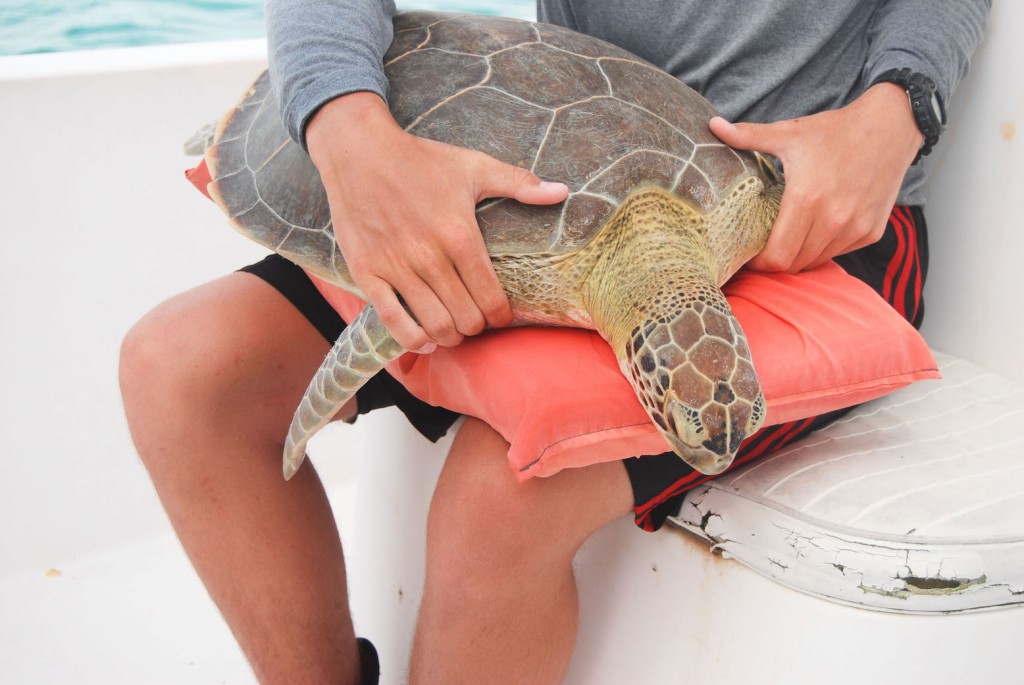
Student Update: Research
Students have been busy this week pouring over the data they have collected all semester in Research class and trying to make sense of their results. Here’s what student Khalil has to say about his research experience.
In a twenty-minute boat ride from The Island School boathouse, you may see a buoy. Beneath this buoy or pair of buoys there is a rope that reaches eight-hundred to one-thousand one-hundred meters beneath the water, leading to 22-26 hooks catching sharks and occasionally bony fish, or it holds a 7 foot cage holding gulper sharks and Cuban dogfish and a few cameras for The Cape Eluethera Institute and Island School scientists to investigate the post-release mortality rate and factors effecting the mortality rate of gulper sharks and Cuban dogfish. In a group of six Island School students and two CEI researchers as teachers, we are researching to study and find the death rate of gulper sharks and Cuban dogfish after they have been caught and released on long-lines as by-catch by commercial fisheries. We also study the factors that affect the mortality rates. In doing this research project I have had a lot of fun, and we have become experts in gulper shark and Cuban dogfish taxonomy, and stress responses, and we are great at pulling up long-lines even in hard-rocking waves and rain. We joke with our teacher, telling him that we will save the sharks, and that his spirit animal is a Cuban dogfish, even though our goal is to inform fishery management, and everyone knows his spirit animal is actually a cheetah. All in all I have learned a lot and had a lot of fun in Shark research.
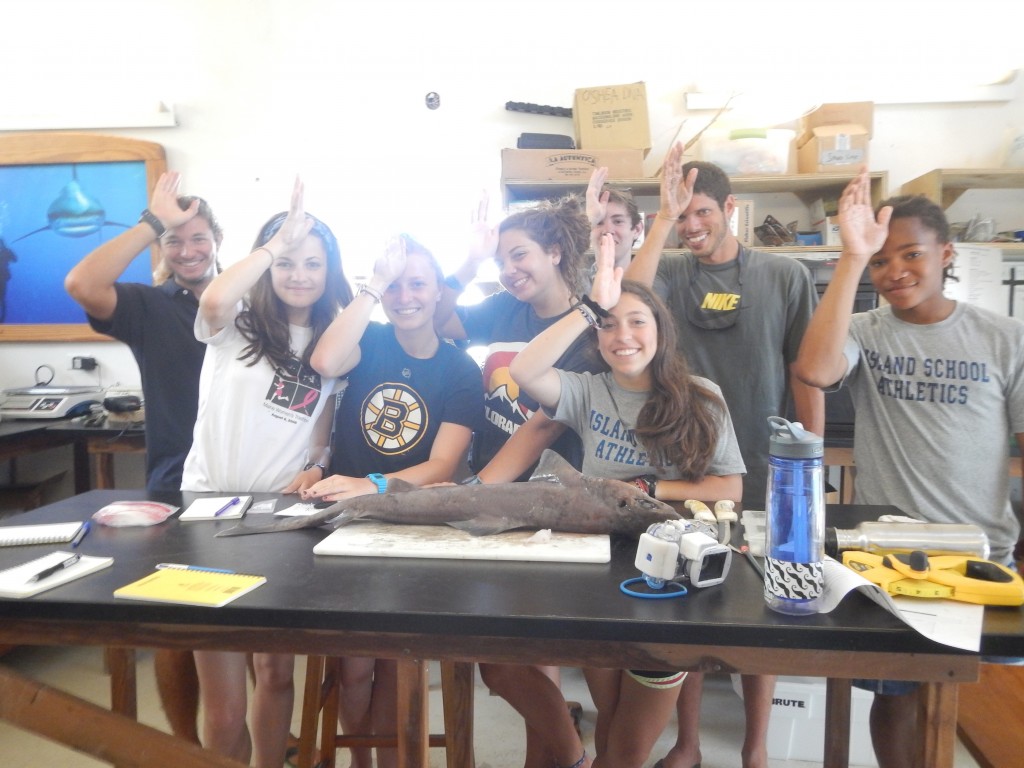
Rachel Miller Attends Southeast Regional Sea Turtle Meeting
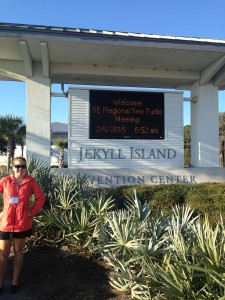
Earlier in February, Rachel Miller, the Research Assistant for the Sea Turtle Conservation Program, attended the Southeast Regional Sea Turtle Meeting in Jekyll Island, GA, a five-day conference that focused on the newest sea turtle research from the Southeast United States. In addition to learning about the newest sea turtle research, Rachel had the opportunity to meet with top scientists, upcoming scientists, and Island School alumni. At the conference, Rachel met IS alumna Sarah Kollar (S’07) who is working with the Trash Free Seas division of the Ocean Conservancy in Washington, DC. It’s awesome to see where Island School has reached! You can find out more about SERST here.
Island School Students Invade CEI
For the Island School summer term, six students had the opportunity to work with Dr. Jocelyn Curtis-Quick researching invasive lionfish. In one day, the students became professionals at cast netting, dissecting lionfish, conducting behavior observations, and data analysis. They dissected fourteen lionfish, with body fat ranging from% 0.58- %2.1 and the discovered of various prey items in the stomach including crabs, grunts, and blue headed wrasse. Shockingly, there were twelve fish in one stomach; proving the voracious eating habits of the lionfish. The students are now knowledgeable invasive lionfish researchers. Of course, the students love to eat lionfish and recommend everyone do their part to stop the invasion by eating them.
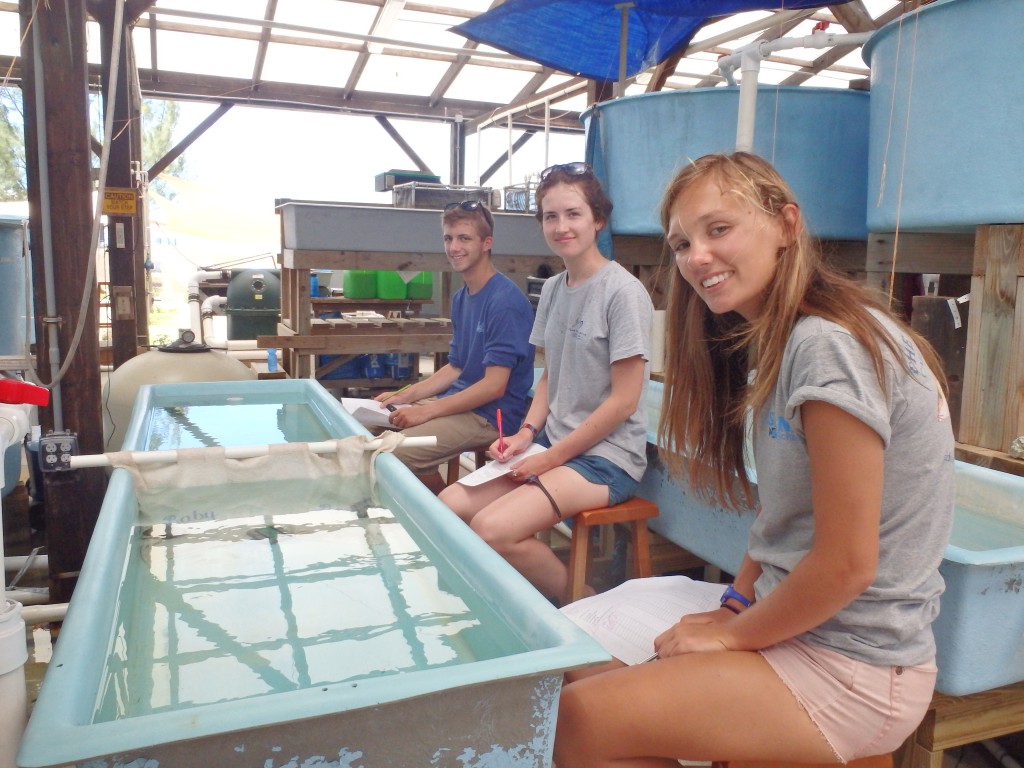
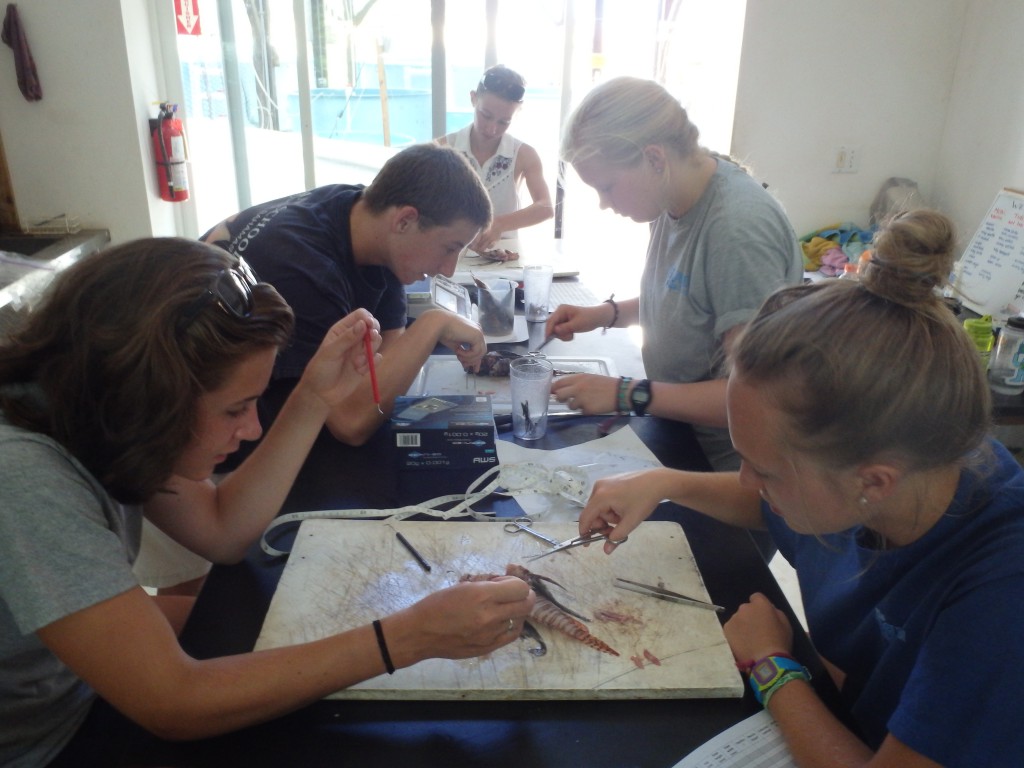
Summer Term 2013: Student Update July 14, 2013
During the fifth day of each academic rotation for Human Ecology: Food Systems, students get the opportunity to participate in one of three CEI research projects: turtles, sharks, and bonefish. Here is an excerpt from our day on the field working with the turtle team on Friday!
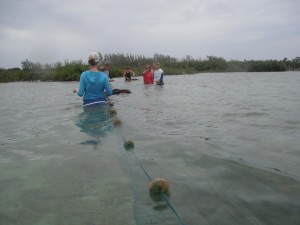
It was a gloomy Friday morning in terms of weather, but The Island school kids were ready to go. Smiles, music, and gossip about turtle names drifts through the van on our way to Half Sound, an embayment 45 minutes north of school. Tagging turtles for research is not for the faint-hearted, and the Island School team showed up ready to get some catches. After a long ride to the creek we finally arrived, ready and waiting for the first turtle to cross our path. After a small talk about the movement of the tides and how it affects the destination of the turtles in the creek system, we quickly set up the net for the first capture. Turtle-ing requires patience and interaction with your peers. As we quietly form a line yards away, we face the net and walk back kicking and splashing as loud as we can. This may sound easy, but after a few hours and a mini lunch break in the water, we found ourselves worried that the turtles had outsmarted us. With our doubts we set up our net with a different technique. Instead of keeping the net in one location, making it easier for the turtle to escape, we moved the net around the people herding, hoping to get the turtle in the circle. After turtles made it out of the circle by jumping over the net and moving under the net, we made our first catch!
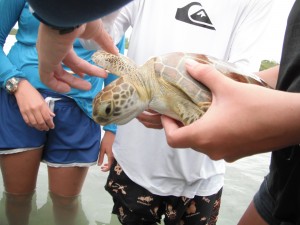
After the catch, we quickly proceeded to take care of business. Turtles are able to live outside of water, but we always wanted to make sure the turtle is not stressed through the process. We went on to tagging where we insert a tag on each of the turtle’s front fins so that if he or she was to show up in a new location and somebody found them, they would know who to contact and get an idea of growth rate. We also recorded the species, width, weight, and length of the turtle. The process was not lengthy and the turtle swam off unharmed and quickly. Although this green sea turtle was our only catch of the day, The Island School crew and the help of a few researchers from CEI put in the effort, making this a successful quest for turtles!
Thanks to Gabi for this Student Update!
Sea Turtle Team
[slideshow]
Sea turtles are on the endangered species Red List. The most common species of turtle found in the Bahamas is the green turtle, which we are studying. Previous studies in the Bahamas have included nutrition, grazing, growth rates, and abundance, but none have been conducted on Eleuthera. Our study is currently being conducted just north of Rock Sound in Half Sound, on the Atlantic side of the island. The purpose of our study is to investigate the abundance, size, and distribution of green sea turtles in Half Sound and our hypothesis is that areas with an abundance of sea grass will have dense turtle populations. We have two main methods that we’ve used so far in order to catch these turtles. The first is by boat, in which we take a small skiff to Half Sound. We ride Continue reading
Island School Students’ First Week of Research Class
Research classes kicked off this week for The Island School students. On Tuesday, students broke into their 8 different research groups and spent the afternoon getting to know their research advisors–members of the research team at the Cape Eleuthera Institute (CEI). They also learned about the study they would be working on for the next 3 months. Thursday afternoon was their first field block, where they got out on the water or into the lab for the first time! The 8 studies being conducted this semester focus on shark ecology & physiology, the impact of climate change on bonefish & mangrove flats species, lionfish & reef fish population ecology, and sea turtle & conch abundance & distribution around South Eleuthera. These studies are well-established areas of research at CEI and as a result, many visitors and collaborators will be visiting our campus over the next few weeks to share their knowledge and expertise with the students.
Research class is an exciting opportunity for students to gain new skills in the field – from fish identification and handling to public speaking and PowerPoint creation. Students learn about and contribute to global conservation issues, work in small groups, and ultimately, have the experience of a lifetime!
[slideshow]

